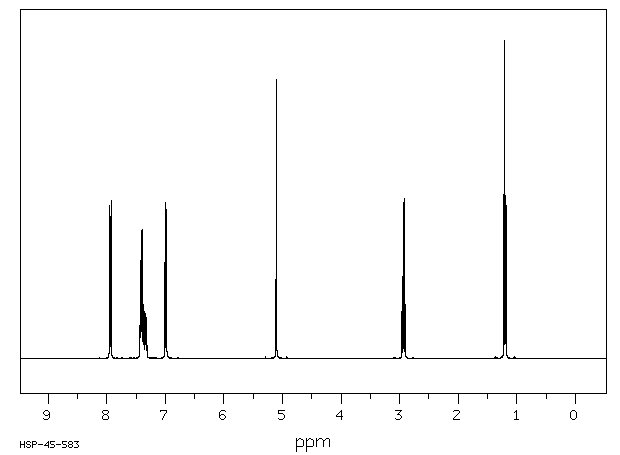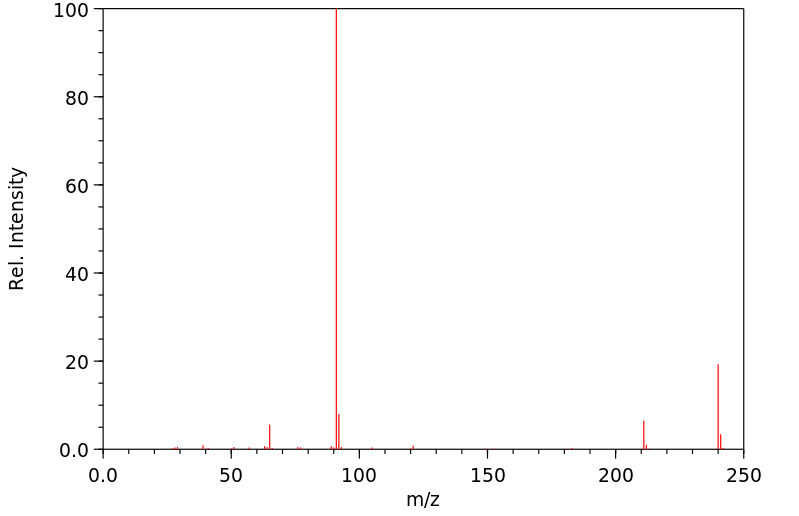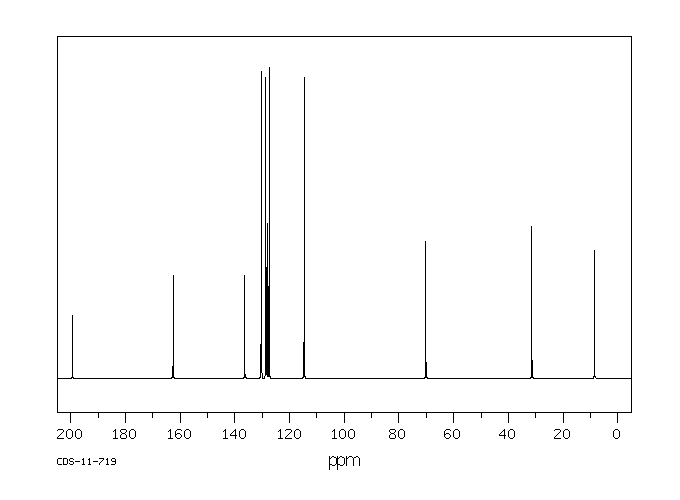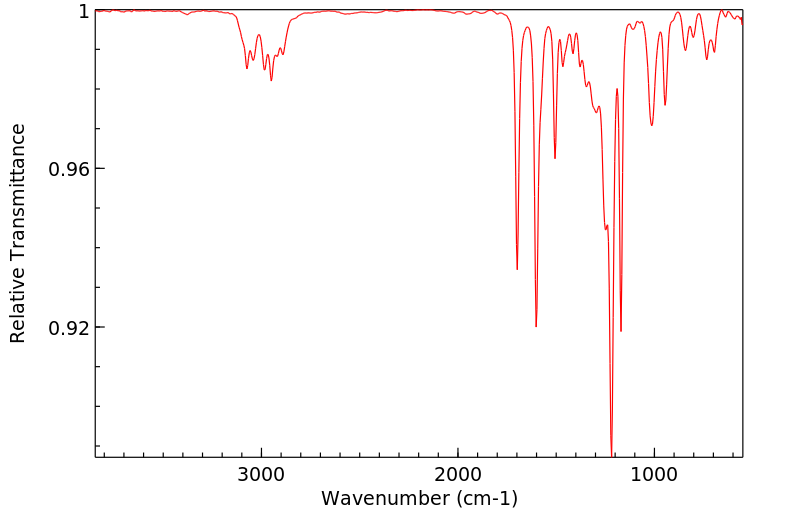4‘-苄氧基苯丙酮 | 4495-66-3
中文名称
4‘-苄氧基苯丙酮
中文别名
4-苄氧基苯丙酮;4'-苄氧基苯丙酮;(4-苄氧苯基)乙基酮;1-(4-(苄氧基)苯基)丙-1-酮
英文名称
4-benzyloxypropiophenone
英文别名
1-(4-(benzyloxy)phenyl)propan-1-one;1-(4-phenylmethoxyphenyl)propan-1-one
CAS
4495-66-3
化学式
C16H16O2
mdl
MFCD00009311
分子量
240.302
InChiKey
IKFGSOJYHVTNDV-UHFFFAOYSA-N
BEILSTEIN
——
EINECS
——
-
物化性质
-
计算性质
-
ADMET
-
安全信息
-
SDS
-
制备方法与用途
-
上下游信息
-
文献信息
-
表征谱图
-
同类化合物
-
相关功能分类
-
相关结构分类
物化性质
-
熔点:99-102 °C
-
沸点:343.02°C (rough estimate)
-
密度:1.0752 (rough estimate)
-
溶解度:溶于二氯甲烷、乙酸乙酯、甲醇
-
LogP:3.930 (est)
-
稳定性/保质期:
常温常压下稳定,结晶。熔点为100-102℃。
计算性质
-
辛醇/水分配系数(LogP):3.9
-
重原子数:18
-
可旋转键数:5
-
环数:2.0
-
sp3杂化的碳原子比例:0.187
-
拓扑面积:26.3
-
氢给体数:0
-
氢受体数:2
安全信息
-
安全说明:S24/25
-
海关编码:2914509090
-
储存条件:请将药品存放在避光、通风干燥的地方,并密封保存。
SDS
| Name: | 4 -Benzyloxypropiophenone 99% Material Safety Data Sheet |
| Synonym: | None known |
| CAS: | 4495-66-3 |
Synonym:None known
Section 2 - COMPOSITION, INFORMATION ON INGREDIENTS
| CAS# | Chemical Name | content | EINECS# |
| 4495-66-3 | 4'-Benzyloxypropiophenone | 99 | 224-788-2 |
Risk Phrases: None Listed.
Section 3 - HAZARDS IDENTIFICATION
EMERGENCY OVERVIEW
The toxicological properties of this material have not been fully investigated.
Potential Health Effects
Eye:
May cause eye irritation.
Skin:
May cause skin irritation.
Ingestion:
May cause irritation of the digestive tract. The toxicological properties of this substance have not been fully investigated.
Inhalation:
May cause respiratory tract irritation. The toxicological properties of this substance have not been fully investigated.
Chronic:
No information found.
Section 4 - FIRST AID MEASURES
Eyes: Flush eyes with plenty of water for at least 15 minutes, occasionally lifting the upper and lower eyelids. Get medical aid.
Skin:
Get medical aid. Flush skin with plenty of water for at least 15 minutes while removing contaminated clothing and shoes. Wash clothing before reuse.
Ingestion:
Never give anything by mouth to an unconscious person. Get medical aid. Do NOT induce vomiting. If conscious and alert, rinse mouth and drink 2-4 cupfuls of milk or water.
Inhalation:
Remove from exposure and move to fresh air immediately. If not breathing, give artificial respiration. If breathing is difficult, give oxygen. Get medical aid.
Notes to Physician:
Section 5 - FIRE FIGHTING MEASURES
General Information:
As in any fire, wear a self-contained breathing apparatus in pressure-demand, MSHA/NIOSH (approved or equivalent), and full protective gear. During a fire, irritating and highly toxic gases may be generated by thermal decomposition or combustion.
Extinguishing Media:
Use agent most appropriate to extinguish fire. Use water spray, dry chemical, carbon dioxide, or appropriate foam.
Section 6 - ACCIDENTAL RELEASE MEASURES
General Information: Use proper personal protective equipment as indicated in Section 8.
Spills/Leaks:
Vacuum or sweep up material and place into a suitable disposal container. Clean up spills immediately, observing precautions in the Protective Equipment section. Avoid generating dusty conditions.
Provide ventilation.
Section 7 - HANDLING and STORAGE
Handling:
Wash thoroughly after handling. Remove contaminated clothing and wash before reuse. Use with adequate ventilation. Minimize dust generation and accumulation. Avoid contact with eyes, skin, and clothing. Keep container tightly closed. Avoid ingestion and inhalation.
Storage:
Store in a tightly closed container. Store in a cool, dry, well-ventilated area away from incompatible substances.
Section 8 - EXPOSURE CONTROLS, PERSONAL PROTECTION
Engineering Controls:
Facilities storing or utilizing this material should be equipped with an eyewash facility and a safety shower. Use adequate ventilation to keep airborne concentrations low.
Exposure Limits CAS# 4495-66-3: Personal Protective Equipment Eyes: Wear appropriate protective eyeglasses or chemical safety goggles as described by OSHA's eye and face protection regulations in 29 CFR 1910.133 or European Standard EN166.
Skin:
Wear appropriate protective gloves to prevent skin exposure.
Clothing:
Wear appropriate protective clothing to prevent skin exposure.
Respirators:
A respiratory protection program that meets OSHA's 29 CFR 1910.134 and ANSI Z88.2 requirements or European Standard EN 149 must be followed whenever workplace conditions warrant respirator use.
Section 9 - PHYSICAL AND CHEMICAL PROPERTIES
Physical State: Powder
Color: slightly beige
Odor: none reported
pH: Not available.
Vapor Pressure: Not available.
Viscosity: Not available.
Boiling Point: Not available.
Freezing/Melting Point: 100.00 - 102.00 deg C
Autoignition Temperature: Not applicable.
Flash Point: Not applicable.
Explosion Limits, lower: Not available.
Explosion Limits, upper: Not available.
Decomposition Temperature:
Solubility in water:
Specific Gravity/Density:
Molecular Formula: C16H16O2
Molecular Weight: 240.30
Section 10 - STABILITY AND REACTIVITY
Chemical Stability:
Stable under normal temperatures and pressures.
Conditions to Avoid:
Incompatible materials, dust generation, excess heat, strong oxidants.
Incompatibilities with Other Materials:
Oxidizing agents.
Hazardous Decomposition Products:
Carbon monoxide, irritating and toxic fumes and gases, carbon dioxide.
Hazardous Polymerization: Has not been reported
Section 11 - TOXICOLOGICAL INFORMATION
RTECS#:
CAS# 4495-66-3 unlisted.
LD50/LC50:
Not available.
Carcinogenicity:
4'-Benzyloxypropiophenone - Not listed by ACGIH, IARC, or NTP.
Section 12 - ECOLOGICAL INFORMATION
Section 13 - DISPOSAL CONSIDERATIONS
Dispose of in a manner consistent with federal, state, and local regulations.
Section 14 - TRANSPORT INFORMATION
IATA
Not regulated as a hazardous material.
IMO
Not regulated as a hazardous material.
RID/ADR
Not regulated as a hazardous material.
Section 15 - REGULATORY INFORMATION
European/International Regulations
European Labeling in Accordance with EC Directives
Hazard Symbols: Not available.
Risk Phrases:
Safety Phrases:
S 24/25 Avoid contact with skin and eyes.
S 28A After contact with skin, wash immediately with
plenty of water.
S 37 Wear suitable gloves.
S 45 In case of accident or if you feel unwell, seek
medical advice immediately (show the label where
possible).
WGK (Water Danger/Protection)
CAS# 4495-66-3: No information available.
Canada
None of the chemicals in this product are listed on the DSL/NDSL list.
CAS# 4495-66-3 is not listed on Canada's Ingredient Disclosure List.
US FEDERAL
TSCA
CAS# 4495-66-3 is not listed on the TSCA inventory.
It is for research and development use only.
SECTION 16 - ADDITIONAL INFORMATION
N/A
制备方法与用途
化学性质:结晶状,熔点为100-102℃。
用途:作为利托君的中间体。
上下游信息
-
上游原料
中文名称 英文名称 CAS号 化学式 分子量 4'-苯甲氧基-2-溴苯丙酮 1-<4-(benzyloxy)phenyl>-2-bromo-1-propanone 35081-45-9 C16H15BrO2 319.198 4-苄氧基苯甲醛 p-benzyloxybenzaldehyde 4397-53-9 C14H12O2 212.248 4-苯甲氧基苯甲酸 p-(benzyloxy)benzoic acid 1486-51-7 C14H12O3 228.247 4-羟基苯丙酮 4-hydroxypropiophenone 70-70-2 C9H10O2 150.177 —— 1-(4-(benzyloxy)phenyl)prop-2-en-1-ol 470665-13-5 C16H16O2 240.302 —— (E)-(benzyloxy)-4-(3-chloroprop-1-enyl)benzene 87030-16-8 C16H15ClO 258.748 -
下游产品
中文名称 英文名称 CAS号 化学式 分子量 4'-苯甲氧基-2-溴苯丙酮 1-<4-(benzyloxy)phenyl>-2-bromo-1-propanone 35081-45-9 C16H15BrO2 319.198 苯丙酮杂质2 1-(4-benzyloxy-phenyl)-2-chloro-propan-1-one 111000-54-5 C16H15ClO2 274.747 4-羟基苯丙酮 4-hydroxypropiophenone 70-70-2 C9H10O2 150.177 —— Acetic acid 2-(4-benzyloxy-phenyl)-1-methyl-2-oxo-ethyl ester 200353-85-1 C18H18O4 298.339 —— Ethyl 4-[4-(benzyloxy)phenyl]-3-methyl-4-oxobutanoate 403482-45-1 C20H22O4 326.392 —— 1-(4-Benzyloxy-phenyl)-3-(hydroxy-methyl-amino)-2-methyl-propenone 143620-97-7 C18H19NO3 297.354 —— 2-Benzylamino-1-(4-benzyloxy-phenyl)-propan-1-one 62634-51-9 C23H23NO2 345.441 —— 1-(4-benzyloxyphenyl)-2-(4-benzyloxy-phenylamino)-1-propanone 1048697-94-4 C29H27NO3 437.538 1-[4-(苯基甲氧基)苯基]-2-[4-(苯基甲基)哌啶-1-基]丙-1-酮 1-(4-(benzyloxy)phenyl)-2-(4-benzylpiperidin-1-yl)propan-1-one 35133-39-2 C28H31NO2 413.56 —— (Z/E)-1-benzyloxy-4-[1-(bromofluoromethylene)propyl]benzene 729613-24-5 C17H16BrFO 335.216
反应信息
-
作为反应物:参考文献:名称:In vitro bioactivation of bazedoxifene and 2-(4-hydroxyphenyl)-3-methyl-1H-indol-5-ol in human liver microsomes摘要:Bazedoxifene is a selective estrogen receptor modulator (SERM) that has been developed for use in postmenopausal osteoporosis. However, it contains a potentially toxic 5-hydroxy-3-methylindole moiety. Previous studies on the 5-hydroxyindole and the 3-alkylindole-containing drugs indometacine, zafirlukast and MK-0524 structural analogs have shown that they are bioactivated by cytochrome P450s through a dehydrogenation process to form quinoneimine or 3-methyleneindolenine electrophilic species. In the present study, bazedoxifene was synthesized and then evaluated, together with raloxifene and 2-(4-hydroxyphenyl)-3-methyl-1H-indol-5-ol (13), a 3-methyl-5-hydroxyindole-based structural fragment of bazedoxifene, for its ability to form reactive electrophilic species when incubated with human liver microsomes (HLMs) or recombinant CYP isozymes. We showed that bazedoxifene was bioactivated only in trace amounts with recombinant CYP isozymes. In contrast, the N-dealkylated fragment of bazedoxifene (2-(4-hydroxyphenyl)-3-methyl-1H-indol-5-ol) was bioactivated in considerable amounts to an electrophilic intermediate, which was trapped with glutathione and identified by LC-MS/MS. This suggests that bazedoxifene would require initial N-dealkylation, which could subsequently lead to the formation of the reactive intermediate. However, such an N-dealkylated metabolite of bazedoxifene was not detected after the incubation of bazedoxifene in HLM or recombinant CYP isozymes. (C) 2012 Elsevier Ireland Ltd. All rights reserved.DOI:10.1016/j.cbi.2012.03.001
-
作为产物:描述:参考文献:名称:A facile and versatile electro-reductive system for hydrodefunctionalization under ambient conditions摘要:
描述了一种使用三乙胺作为牺牲还原剂的简便电还原去功能化系统,通过简单地改变反应溶剂,可以方便地切换还原的选择性和能力。
DOI:10.1039/d1gc00317h -
作为试剂:参考文献:名称:PROCESSES AND INTERMEDIATES FOR PREPARING INDOLE PHARMACEUTICALS摘要:本发明涉及制备含有吲哚的药物的过程和中间体,特别是制备选择性雌激素受体调节剂(如巴泽多西芬)的过程和中间体。公开号:US20160107991A1
文献信息
-
Fe(0)-Mediated Synthesis of Tri- and Tetra-Substituted Olefins from Carbonyls: An Environmentally Friendly Alternative to Cr(II)作者:J. R. Falck、Romain Bejot、Deb K. Barma、Anish Bandyopadhyay、Suju Joseph、Charles MioskowskiDOI:10.1021/jo061445u日期:2006.10.1carbonyls by activated polyhalides. In many instances, Fe(0) was equivalent or superior to Cr(II). Notably, Fe(0), but not Cr(II), proved compatible with a wide range of functionality, inter alia, unprotected phenol, aryl nitro, carboxylic acid, and alkyl nitrile. A surprising reversal of stereoselectivity for aldehydes versus ketones was observed using both metals. The resultant α-halo-α,β-unsaturated or α
-
Iodine Promoted Regioselective α-Sulfenylation of Carbonyl Compounds using Dimethyl Sulfoxide as an Oxidant作者:Yogesh Siddaraju、Kandikere Ramaiah PrabhuDOI:10.1021/acs.orglett.6b03084日期:2016.12.2A metal-free regioselective sulfenylation of the α-CH3 group of ketones has been achieved in the presence of the α-CH2 or α-CH group using the cross dehydrogenative (CDC) strategy. Aldehydes also exhibit good selectivity forming the corresponding α-sulfenylated products. This efficient sulfenylation of ketones or aldehydes with thiones or heterocyclic thiols utilizes dimethyl sulfoxide (DMSO) as an
-
Mechanistic study on iodine-catalyzed aromatic bromination of aryl ethers by N -Bromosuccinimide作者:Pranab Kumar Pramanick、Zhen-Lin Hou、Bo YaoDOI:10.1016/j.tet.2017.10.073日期:2017.12Although iodine-catalyzed reaction has rapid advances in recent years, examples on iodine-catalyzed bromination are rare and the mechanism of these reactions remains unclear. Herein, we reported an I2-catalyzed aromatic bromination of aryl ethers by NBS and presented the details of the mechanistic study including kinetic study and the study of kinetic isotope effects. The study revealed that the reaction
-
α,β-Functionalization of saturated ketones with anthranils via Cu-catalyzed sequential dehydrogenation/aza-Michael addition/annulation cascade reactions in one-pot作者:Dipak Kumar Tiwari、Mandalaparthi Phanindrudu、Sandip Balasaheb Wakade、Jagadeesh Babu Nanubolu、Dharmendra Kumar TiwariDOI:10.1039/c7cc01195d日期:——An efficient method to access functionalized quinolines from the readily available saturated ketones and anthranils have been explored. This one-pot cascade reaction involves the in situ generation of α,β-unsaturated ketones by the copper catalysed dehydrogenation of saturated ketones followed by the aza-Michael addition of anthranils and subsequent annulation.
-
Iron-Catalyzed Highly Enantioselective Hydrogenation of Alkenes作者:Peng Lu、Xiang Ren、Haofeng Xu、Dongpo Lu、Yufeng Sun、Zhan LuDOI:10.1021/jacs.1c04773日期:2021.8.18for the first time an iron-catalyzed highly enantioselective hydrogenation of minimally functionalized 1,1-disubstituted alkenes to access chiral alkanes with full conversion and excellent ee. A novel chiral 8-oxazoline iminoquinoline ligand and its iron complex have been designed and synthesized. This protocol is operationally simple by using 1 atm of hydrogen gas and shows good functional group tolerance
表征谱图
-
氢谱1HNMR
-
质谱MS
-
碳谱13CNMR
-
红外IR
-
拉曼Raman
-
峰位数据
-
峰位匹配
-
表征信息
同类化合物
(反式)-4-壬烯醛
(s)-2,3-二羟基丙酸甲酯
([1-(甲氧基甲基)-1H-1,2,4-三唑-5-基](苯基)甲酮)
(Z)-4-辛烯醛
(S)-氨基甲酸酯β-D-O-葡糖醛酸
(S)-3-(((2,2-二氟-1-羟基-7-(甲基磺酰基)-2,3-二氢-1H-茚满-4-基)氧基)-5-氟苄腈
(R)-氨基甲酸酯β-D-O-葡糖醛酸
(5,5-二甲基-2-(哌啶-2-基)环己烷-1,3-二酮)
(2,5-二氟苯基)-4-哌啶基-甲酮
龙胆苦苷
龙胆二糖甲乙酮氰醇(P)
龙胆二糖丙酮氰醇(P)
龙胆三糖
龙涎酮
齐罗硅酮
齐留通beta-D-葡糖苷酸
鼠李糖
黑芥子苷单钾盐
黑海棉酸钠盐
黑木金合欢素
黑曲霉三糖
黑介子苷
黄尿酸8-O-葡糖苷
麻西那霉素II
麦迪霉素
麦芽糖脎
麦芽糖基海藻糖
麦芽糖1-磷酸酯
麦芽糖
麦芽四糖醇
麦芽四糖
麦芽十糖
麦芽六糖
麦芽五糖水合物
麦芽五糖
麦芽五糖
麦芽五糖
麦芽三糖醇
麦芽三糖
麦芽三糖
麦芽三塘水合
麦芽七糖水合物
麦芽七糖
麦法朵
麦可酚酸-酰基-Β-D-葡糖苷酸
麦利查咪
麝香酮
鹤草酚
鸢尾酚酮 3-C-beta-D-吡喃葡萄糖苷
鸡矢藤苷










